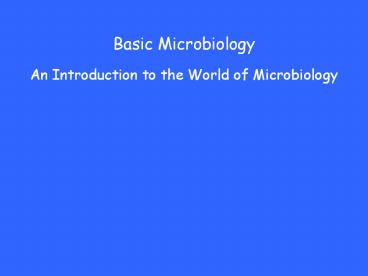Basic Microbiology - PowerPoint PPT Presentation
1 / 23
Title:
Basic Microbiology
Description:
He started forcing doctors under his supervision to wash their hands before touching patients. ... 1867: Joseph Lister (1827-1912) introduced antiseptics in surgery. ... – PowerPoint PPT presentation
Number of Views:7579
Avg rating:3.0/5.0
Title: Basic Microbiology
1
Basic Microbiology
- An Introduction to the World of Microbiology
2
(No Transcript)
3
1. Archaea
- Archaea Extremophiles -Very small bacteria that
are adapted to extreme conditions - Thermophiles- extreme heat
- Psychrophiles Cold( ice caps)
- Halophiles high concentrations of salt
- Methanogens live in a hostile environment and
produce methane gas as a by product of their life
style - Sulfur loving bacteria live in high
concentrations of sulfurous gases
4
(No Transcript)
5
2. Bacteria
- Eubacteria True bacteria Includes
environmental bacteria such as nitrogen fixing
bacteria and bacteria of decay and decomposition
as well as pathogens. - Cyanobacteria Formerly known as blue green
algae small, unicellular algae found in ponds,
lakes, streams, and the ocean. Essential to the
web of life
6
(No Transcript)
7
Prokaryote cells
- Are very small and undifferentiated
- Lack a nuclear membrane
- Lack cellular organelles like mitochondria
- Have unique cell walls and cell membranes
- Have only one circular chromosome
8
(No Transcript)
9
Bacterial Growth Cell Division Binary fission
10
Bacterial cells can be seen with a light
microscope or an electron microscope
11
3. Eukarya
- Includes
- Protozoans
- Algae
- Fungi
- Animals and Plants
12
(No Transcript)
13
Historical Roots of Microbiology
14
1660 Robert Hooke (1635-1703) published
"Micrographia", containing drawings and detailed
observations of biological materials made with
the best compound microscope and illumination
system of the time. 1676 Anton von Leeunhoek
(1632-1723) was the first person to observe
microorganisms. 1883 Carl Zeiss pioneered
developments in microscopy (such as immersion
lenses and apochromatic lenses which reduce
chromatic aberration) which perist until the
present day. 1931 Ernst Rusko -constructed the
first electron microscope.
Microscopy
15
1688 Francesco Redi (1626-1678) was an Italian
physician who refuted the idea of spontaneous
generation by showing that rotting meat carefully
kept from flies will not spontaneously produce
maggots. 1836 Theodor Schwann (1810-1882)
helped develop the cell theory of living
organisms, namely that that all living organisms
are composed of one or more cells and that the
cell is the basic functional unit of living
organisms. 1861 Louis Pasteur (1822-1895)
famous experiments with swan-necked flasks
finally proved that microorganisms do not arise
by spontaneous generation.
16
Redis Experiment
17
(No Transcript)
18
Edward Jenner
19
1546 Hieronomus Fracastoro (Girolamo Fracastoro)
wrote "On Contagion" ("De contagione et
contagiosis morbis et curatione"), the the first
known discussion of the phenomenon of contagious
infection. 1835 Agostino Bassi de Lodi showed
that a disease affecting silkworms was caused by
a fungus - the first microorganism to be
recognized as a contagious agent of animal
disease. 1847 Ignaz Semmelweis (1818-1865), a
Hungarian physician who decided that doctors in
Vienna hospitals were spreading childbed fever
while delivering babies. He started forcing
doctors under his supervision to wash their hands
before touching patients. 1857 Louis Pasteur
proposed the "germ theory" of disease. 1867
Joseph Lister (1827-1912) introduced antiseptics
in surgery. By spraying carbolic acid on surgical
instruments, wounds and dressings, he reduced
surgical mortality due to bacterial infection
considerably
20
Listers Carboxylic spray
Pasteur Fermentation
Sterile Surgery
Beer and Bread
21
1876 Robert Koch (1843-1910). German
bacteriologist was the first to cultivate anthrax
bacteria outside the body using blood serum at
body temperature. Building on pasteur's "germ
theory", he subsequently published "Koch's
postulates" (1884), the critical test for the
involvement of a microorganism in a disease The
agent must be present in every case of the
disease. The agent must be isolated and cultured
in vitro. The disease must be reproduced when a
pure culture of the agent is inoculated into a
susceptible host. The agent must be recoverable
from the experimentally-infected host.
22
Fields of Microbiology Bacteriology Virology Epide
miology Immunology Parasitology
Protozoology Mycology Virology
23
Modern Microbiology
Recombinant DNA technology and genetic
engineering Biotechnology































